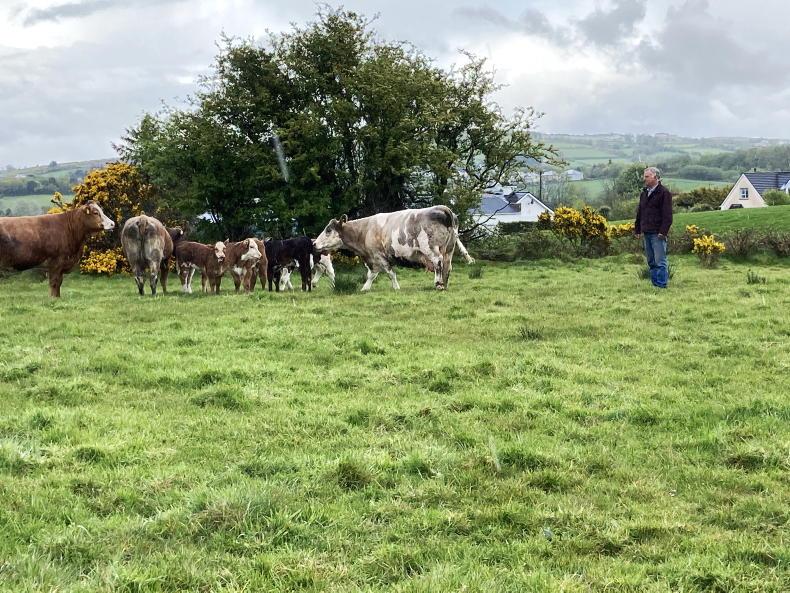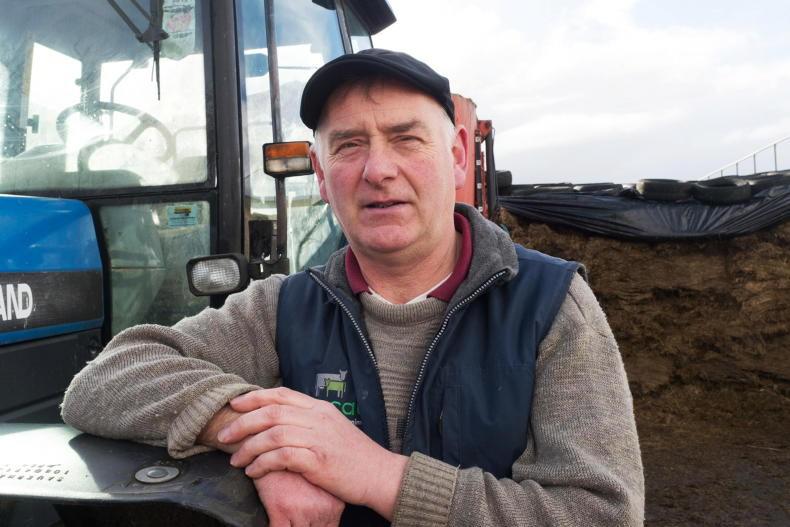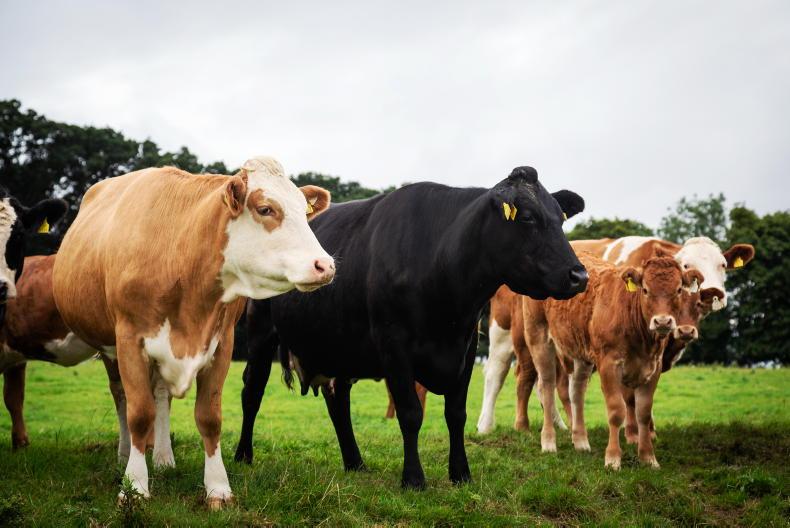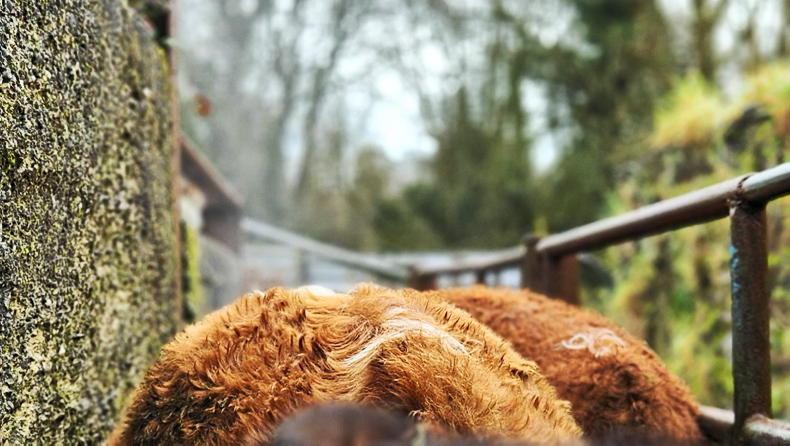Frank McClean is a full-time farmer with a passion to breed quality cattle. “Breeding anything other than top-end calves doesn’t pay in this game. The farm here consists of 65 suckler cows and followers,” Frank says.
Frank is currently farming 120ac of predominantly heavy land with some dry parts.
Like many farms in the west, this is split into different plots and out farms with the home farm currently only 30ac. Another 30ac are owned about three miles away from the house, as well as a block of 60ac leased, which is about three miles away from the home farm.
Up until 2008, the farm was solely a dairy enterprise milking 45 cows, but due to the need to upgrade buildings and the parlour, the decision was made to exit dairying.

Frank McClean, Donegal. \ Clive Wasson
“I thought long and hard about it but it was going to cost too much and with only 30 acres around the yard, it wasn’t viable to invest,” Frank says.
He always had a passion to breed quality cattle, having several times taken home top prices on sale days for young suck calves out of the dairy cows, so the natural decision was to get into suckling.
Frank is currently running a suckler-to-weanling/store system with some weanlings being sold in autumn, as well as some stores in the spring of each year. He runs a traditional spring-calving system where calving starts in January and runs until mid-April.
The early bull calves are all sold as weanling bulls to a local beef finisher in the autumn averaging around 420kg at eight to nine months. He agrees a price per kilo for his weanlings at the time of sale and they are weighed going off the farm.

Frank pictured looking at his last batch of cows that calved.
All the rest of Frank’s calves are kept until reaching the yearling stage, with bulls reaching weights of up to 540kg being sold privately to a finisher.
Heifers are all kept until they reach the yearling stage and sold locally in Raphoe Mart.
“Keeping heifers until yearlings allows me a longer time to see how they develop, and I get a better idea of the best replacements to keep as they grow. It’s hard to pick out a very young heifer for breeding.
“Heifers are typically sold at around 460kg and this year I averaged around €1,170 for my 2020-born heifers,” Frank explains.
The area is “predominately Charolais country” and this is clearly seen on Frank’s farm where he runs a CF52-bred stock bull with most of his cows while opting for AI use as well. AI is used mainly on replacement heifers and maybe on some cows to breed milk into the herd.
He has found that some of his stock bull-bred replacements are lacking a little in milk and he feels AI gives him more options for breeding replacements.
Bull selection and the BDGP
Frank believes in producing high-quality beef cattle with good weight for age that grade well, commenting that “nearly 100% of my bull calves would kill out as U grade cattle."
When picking a stock bull, Frank would sooner judge the animal himself rather than go by stars. However, he does admit “there is a place for stars, and they have their benefits.”
Currently, Frank’s bull is sired by the famous CF52 ( Doonally New). His bloodline was a big factor when he was bought as Frank knew the terminal performance of progeny from his breeding.
When selecting AI bulls, Frank would use the calving difficulty ratings because AI is generally on heifers, but he maintains: “I sort of feel that maybe we have put too much emphasis towards calving difficulty and I sometimes think that you lose quality when you focus on it too much.
“I have watched things tight down through the years and I sometimes think that the harder-calved heifer calves often turn out to be the best cows due to the fact they have a wider pelvis.”
Off farm
Frank is the Donegal rep on the national livestock committee of the IFA, where he plays a role by lobbying for improvements in the agri sector.
“I enjoy being part of the committee. There’s lots of work with meetings and stuff but I enjoy it. I also enjoy meeting new people with similar interests as myself through the IFA.
“We have campaigned very hard for suckler cow supports and while we have made progress I think more is needed for the suckler cow to survive. I am genuinely concerned about what the next CAP reform could do to my income.”
The future
A better beef price and a good mart trade have meant there is a renewed confidence in the beef sector. At 62 years of age, Frank does not know where the farm will be in the future as currently his two grown-up children have no interest in farming.
“I would love for either of them to take over the farm someday but I’m not sure that will happen. I’ll continue to run the farm to my upmost best until there comes a time I have to retire.”
“It’s a long time since I left school, but in farming you seem to get an education every day.”“I would love for either of them to take over the farm someday but I’m not sure that will happen.”“I am genuinely concerned about what the next CAP reform could do to my income.”“I sort of feel that maybe we have put too much emphasis towards calving difficulty and I sometimes think that you lose quality when you focus on it too much.”Location:
Pluck, Letterkenny,
Co Donegal
Size: 120ac.System: Suckler-to-weanling/store.Cow numbers: 65.Breeds: Charolais/
Limousin.
Frank McClean is a full-time farmer with a passion to breed quality cattle. “Breeding anything other than top-end calves doesn’t pay in this game. The farm here consists of 65 suckler cows and followers,” Frank says.
Frank is currently farming 120ac of predominantly heavy land with some dry parts.
Like many farms in the west, this is split into different plots and out farms with the home farm currently only 30ac. Another 30ac are owned about three miles away from the house, as well as a block of 60ac leased, which is about three miles away from the home farm.
Up until 2008, the farm was solely a dairy enterprise milking 45 cows, but due to the need to upgrade buildings and the parlour, the decision was made to exit dairying.

Frank McClean, Donegal. \ Clive Wasson
“I thought long and hard about it but it was going to cost too much and with only 30 acres around the yard, it wasn’t viable to invest,” Frank says.
He always had a passion to breed quality cattle, having several times taken home top prices on sale days for young suck calves out of the dairy cows, so the natural decision was to get into suckling.
Frank is currently running a suckler-to-weanling/store system with some weanlings being sold in autumn, as well as some stores in the spring of each year. He runs a traditional spring-calving system where calving starts in January and runs until mid-April.
The early bull calves are all sold as weanling bulls to a local beef finisher in the autumn averaging around 420kg at eight to nine months. He agrees a price per kilo for his weanlings at the time of sale and they are weighed going off the farm.

Frank pictured looking at his last batch of cows that calved.
All the rest of Frank’s calves are kept until reaching the yearling stage, with bulls reaching weights of up to 540kg being sold privately to a finisher.
Heifers are all kept until they reach the yearling stage and sold locally in Raphoe Mart.
“Keeping heifers until yearlings allows me a longer time to see how they develop, and I get a better idea of the best replacements to keep as they grow. It’s hard to pick out a very young heifer for breeding.
“Heifers are typically sold at around 460kg and this year I averaged around €1,170 for my 2020-born heifers,” Frank explains.
The area is “predominately Charolais country” and this is clearly seen on Frank’s farm where he runs a CF52-bred stock bull with most of his cows while opting for AI use as well. AI is used mainly on replacement heifers and maybe on some cows to breed milk into the herd.
He has found that some of his stock bull-bred replacements are lacking a little in milk and he feels AI gives him more options for breeding replacements.
Bull selection and the BDGP
Frank believes in producing high-quality beef cattle with good weight for age that grade well, commenting that “nearly 100% of my bull calves would kill out as U grade cattle."
When picking a stock bull, Frank would sooner judge the animal himself rather than go by stars. However, he does admit “there is a place for stars, and they have their benefits.”
Currently, Frank’s bull is sired by the famous CF52 ( Doonally New). His bloodline was a big factor when he was bought as Frank knew the terminal performance of progeny from his breeding.
When selecting AI bulls, Frank would use the calving difficulty ratings because AI is generally on heifers, but he maintains: “I sort of feel that maybe we have put too much emphasis towards calving difficulty and I sometimes think that you lose quality when you focus on it too much.
“I have watched things tight down through the years and I sometimes think that the harder-calved heifer calves often turn out to be the best cows due to the fact they have a wider pelvis.”
Off farm
Frank is the Donegal rep on the national livestock committee of the IFA, where he plays a role by lobbying for improvements in the agri sector.
“I enjoy being part of the committee. There’s lots of work with meetings and stuff but I enjoy it. I also enjoy meeting new people with similar interests as myself through the IFA.
“We have campaigned very hard for suckler cow supports and while we have made progress I think more is needed for the suckler cow to survive. I am genuinely concerned about what the next CAP reform could do to my income.”
The future
A better beef price and a good mart trade have meant there is a renewed confidence in the beef sector. At 62 years of age, Frank does not know where the farm will be in the future as currently his two grown-up children have no interest in farming.
“I would love for either of them to take over the farm someday but I’m not sure that will happen. I’ll continue to run the farm to my upmost best until there comes a time I have to retire.”
“It’s a long time since I left school, but in farming you seem to get an education every day.”“I would love for either of them to take over the farm someday but I’m not sure that will happen.”“I am genuinely concerned about what the next CAP reform could do to my income.”“I sort of feel that maybe we have put too much emphasis towards calving difficulty and I sometimes think that you lose quality when you focus on it too much.”Location:
Pluck, Letterkenny,
Co Donegal
Size: 120ac.System: Suckler-to-weanling/store.Cow numbers: 65.Breeds: Charolais/
Limousin. 











SHARING OPTIONS